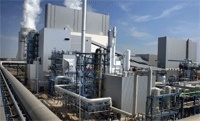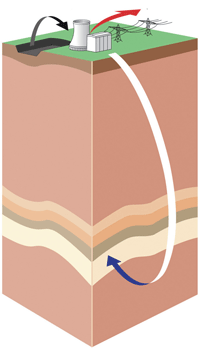Carbon capture and storage (CCS), the process of recovering CO2 from large-scale emitters and burying it deep beneath the ground, is increasingly seen as mankind’s best hope of averting runaway climate change.
However, according to a new report from the government’s Health and Safety Laboratory (HSL), concerns over the safe transport of CO2 need to be addressed if the technology is to fulfil its potential.
Advocates of CCS say that decoupling fossil-fuel use from CO2 emissions will enable mankind to continue to use oil, gas and coal without triggering runaway climate change. However, writing recently in The Engineer, Imperial College’s Prof Jon Gibbins, one of the UK’s foremost CCS experts, warned that, in order to get to this situation, the technology needs to be developed and deployed far more rapidly than is currently the case. Today, all of the world’s CCS plants are, effectively, demonstration schemes. Vattenfall’s 30MW plant at Schwarze Pump in Germany was the first to begin operating in 2008 and several other pilot projects are at varying stages of development. Here in the UK, a proposed 900MW CCS plant in Hatfield, Yorkshire, recently won EC backing, while the government has pledged that no new coal-fired power plants will be built without CCS technology fitted.
The thing with CO2 is it needs to be kept dry. When it gets wet, it gets more corrosive
Dr Lawrence Cusco, HSL
However, to get from this to the wide-scale deployment that experts such as Gibbins claim is essential will require some brave decisions. According to the author of the HSL report, Dr Lawrence Cusco, this process will not be helped by a fundamental blind spot in the thinking of the energy companies and offshore specialists that have so far taken centre stage in the debate.

Cusco, head of fire and process safety at the HSL, told The Engineer that, while the challenges around capture and sequestration are largely understood and proven, the intermediate process, safely transporting CO2 by pressurised pipeline to its final resting place, has received less attention from the CCS community.
He warned that, despite its negative impact on the global climate, the dangers associated with CO2 are often overlooked. As well as creating an asphyxiation hazard by displacing oxygen in the air, CO2 can also increase the acidity of the blood, triggering adverse effects on the cardiovascular, respiratory and central nervous systems. Add to this the fact that there is no initial human sensory response to CO2 release and an accidental leak can be disastrous. Indeed, in August 1986, a natural geological release of the gas from Lake Nyos in Cameroon led to the death of more than 1,700 people. Some paleontologists even claim that a massive geological CO2 leak around 250 million years ago may have led to the mass extinction of 90 per cent of Earth’s animal species and paved the way for the dinosaurs.
Given the large scale of the proposed CCS projects, the potential for leakage from a pipeline close to residential areas is, according to Cusco, a concern that must be taken extremely seriously.
According to his report, CO2 pipelines will pose similar safety concerns to existing oil-and-gas infrastructure and, because in north-western Europe such pipelines would pass close to residential areas, there is an urgent need for a regulatory framework.
Large-scale CO2 transportation also presents some unique challenges of its own, added Cusco. ‘The key thing with CO2 is that it needs to be kept dry,’ he said. ‘When it gets wet, it becomes more corrosive, and as a supercritical fluid it has very good solvent properties, so you have to be careful on the very soft materials such as gaskets and so forth.’

In terms of the types of technology that would be at the heart of a CO2 transport system, there is, said Cusco, plenty already out there. Most promising are the enhanced oil recovery techniques that transport CO2 over long distances before injecting it into older oil reservoirs to improve productivity. This process, used by industry for around 30 years, involves pumping CO2 into an oil reservoir, increasing the reservoir pressure and allowing CO2 to dissolve into the oil and so reducing its viscosity and increasing its volume, allowing oil to flow out more easily.
Interestingly, these techniques have also informed much of the science behind the sequestration issue as although the CO2 is usually extracted at the end of the process, it can also be stored within the reservoir.
As well as these existing techniques, Cusco believes the nascent CCS industry could also create commercial opportunities for smaller companies with gas-handling expertise and engineering companies in the oil-and-gas sector. What’s more, he said, the challenges of building a CO2 infrastructure could help inform the even more complex task of developing a nationwide hydrogen infrastructure. This, added Cusco, would present an even bigger challenge. ‘There are some links, but hydrogen has a different set of challenges in that if you want to use it to refuel vehicles and so on, you need infrastructure for that,’ he said. ‘CCS could be more concentrated; you’re just collecting it for the big emitter sites and then you’re going in a straight line offshore.’
Since publishing the report, Cusco has been in talks with BP and the International Energy EA. Many of his recommendations are now being incorporated into upcoming pipeline safety regulations, he said.
This, added Cusco, is a pleasing contrast to the reaction that greeted him when these safety concerns were first raised, with many in the industrial gases industry and power generation business initially sceptical about the safety issues around CO2 transport.
In an age when ‘health and safety’ has almost become a byword for needless bureaucratic meddling, it must be a reaction that Cusco and his team are only too familiar with. However, he believes that careful consideration at an early stage to safety issues will be key in getting commercial-scale CCS off the ground. ‘We’re trying to make sure safety isn’t a stumbling block and that, by considering it at an early design stage, we design for safety at the beginning. The key thing is acting in an enabling way to help it get done — not to stand in the way of it. The damaging consequences of a CO2 accident could see the court of public opinion rail against the technology and slow the progress of CCS development. Our objective is to understand the implications of this solution so we can mitigate against any potential risk.’
Carbon capture and storage - the facts
- CCS is a group of technologies for capturing the CO2 emitted from power plants and transporting it to permanent storage sites
- Pipelines would be used to transport CO2 to geological sites such as deep saline formations or depleted oil-and-gas fields
- According to the Intergovernmental Panel on Climate Change, the projected potential of CO2 capture is 9-12 per cent of global CO2 emissions in 2020 and 21-45 per cent in 2050
- For new fossil-fuel power plants, CO2 capture can increase the cost of electricity production by 35-85 per cent depending on different assumptions in plant design, operation and financing





Nanogenerator consumes CO2 to generate electricity
Whoopee, they've solved how to keep a light on but not a lot else.